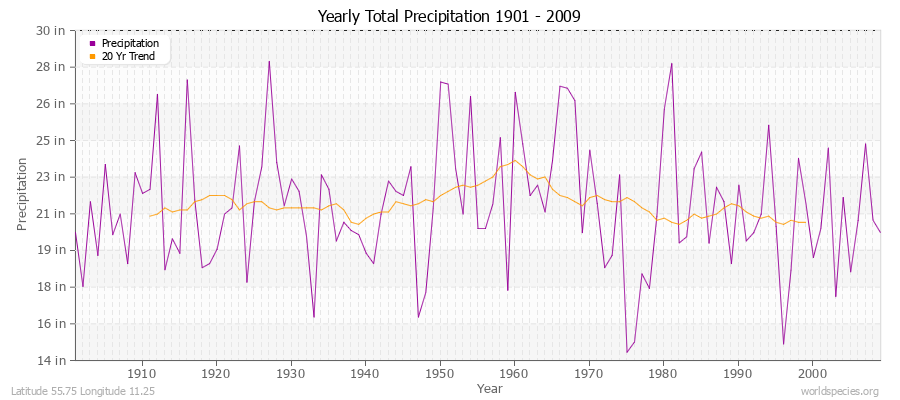Climate Data for Latitude 55.75 Longitude 11.25Köppen climate classification: Cfb (Climate: warm temperate; Precipitation: fully humid; Temperature: warm summer) Åmose, Tissø, Halleby Å og Flasken
Bjergene, Diesebjerg og Bollinge Bakke
Saltbæk Vig
Sejerø Bay and Nekselø
Sejerø Bugt og Saltbæk Vig
Store Åmose, Skarresø og Bregninge Å
Tissø, Lille Åmose and Hallenslev Mose
|
Averages (Metric) English| Type | Units | Jan | Feb | Mar | Apr | May | Jun | Jul | Aug | Sep | Oct | Nov | Dec | Period |
|---|
| Min Temp | C° | -1.0 | -1.4 | -0.0 | 3.2 | 7.5 | 11.2 | 13.7 | 13.7 | 11.2 | 7.6 | 3.9 | 0.8 | 108 years | | Mean Temp | C° | 0.7 | 0.4 | 2.2 | 6.1 | 10.8 | 14.5 | 16.7 | 16.5 | 13.6 | 9.7 | 5.6 | 2.5 | 109 years | | Max Temp | C° | 2.5 | 2.3 | 4.5 | 9.1 | 14.2 | 17.8 | 19.8 | 19.3 | 16.2 | 11.8 | 7.4 | 4.3 | 109 years | | Frost | Days | 30.9 | 28.2 | 31.0 | 17.1 | 19.2 | 10.1 | 1.3 | 3.5 | 6.5 | 16.9 | 18.6 | 29.8 | 6 years | | Wet | Days | 17.1 | 11.0 | 12.5 | 11.1 | 10.1 | 10.2 | 12.2 | 11.8 | 11.8 | 13.4 | 17.1 | 15.1 | 109 years | | Precipitation | mm | 41.1 | 29.1 | 29.7 | 31.8 | 39.2 | 46.3 | 58.8 | 62.5 | 53.2 | 53.5 | 54.2 | 45.6 | 109 years | | Potential Evapotranspiration | mm | 10.6 | 13.2 | 24.7 | 47.9 | 80.4 | 94.3 | 99.0 | 85.0 | 56.5 | 31.2 | 17.2 | 11.5 | 93 years |
Averages (English) Metric| Type | Units | Jan | Feb | Mar | Apr | May | Jun | Jul | Aug | Sep | Oct | Nov | Dec | Period |
|---|
| Min Temp | F° | 30.2 | 29.5 | 32.0 | 37.8 | 45.4 | 52.2 | 56.7 | 56.7 | 52.1 | 45.7 | 38.9 | 33.5 | 108 years | | Mean Temp | F° | 33.3 | 32.8 | 36.0 | 43.0 | 51.4 | 58.0 | 62.1 | 61.7 | 56.6 | 49.5 | 42.1 | 36.5 | 109 years | | Max Temp | F° | 36.5 | 36.1 | 40.1 | 48.3 | 57.5 | 64.0 | 67.7 | 66.8 | 61.1 | 53.3 | 45.3 | 39.7 | 109 years | | Frost | Days | 30.9 | 28.2 | 31.0 | 17.1 | 19.2 | 10.1 | 1.3 | 3.5 | 6.5 | 16.9 | 18.6 | 29.8 | 6 years | | Wet | Days | 17.1 | 11.0 | 12.5 | 11.1 | 10.1 | 10.2 | 12.2 | 11.8 | 11.8 | 13.4 | 17.1 | 15.1 | 109 years | | Precipitation | in | 1.6 | 1.1 | 1.2 | 1.3 | 1.5 | 1.8 | 2.3 | 2.5 | 2.1 | 2.1 | 2.1 | 1.8 | 109 years | | Potential Evapotranspiration | in | 0.4 | 0.5 | 1.0 | 1.9 | 3.2 | 3.7 | 3.9 | 3.3 | 2.2 | 1.2 | 0.7 | 0.5 | 93 years |
Climate data provided by CRU TS 3.1 - University of East Anglia Climate Research Unit (CRU). [Phil Jones, Ian Harris]. CRU Time Series (TS) high resolution gridded datasets, [Internet]. NCAS British Atmospheric Data Centre, 2008, Accessed: 28-July-2011 Charting software provided by pChart - a PHP class to build charts. The calculation method for the potential evapotranspiration is the FAO grass reference equation (Ekstrom et al., 2007, which is based on Allen et al., 1994).
It is a variant of the Penman Monteith method using TMP, TMN, TMX, VAP, CLD.
|









